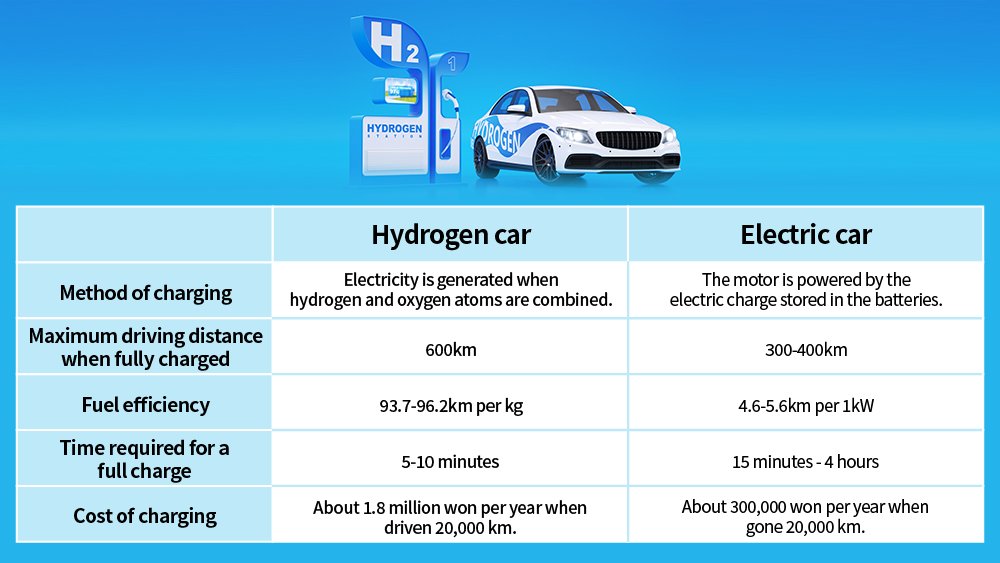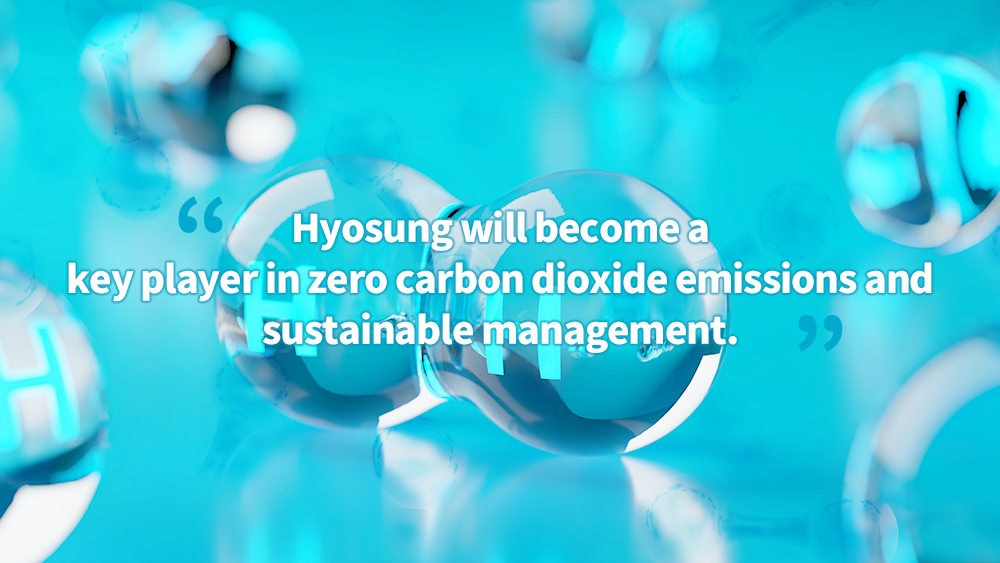Brand Journalism
Brand Journalism
2023-03-20
The Use of Hydrogen in Our Daily Lives Is No Longer Just a Dream for Future Generations!

What is the first thing that springs to mind when you think of the word ‘hydrogen’? You might think of it as something that exists in abundance all around us, as one of the elements of water (H2O) that could be extracted, or as a gas that doesn’t cause environmental pollution and could be used as an energy system – images that suggest ease of supply and environmental friendliness. A hydrogen car propelled by hydrogen is one of the first images that come to mind. Indeed, mobility is one of the sectors where hydrogen is actively used. As a hydrogen specialist company, Hyosung is a group whose subsidiaries are cooperating with various businesses to develop the hydrogen mobility market.
However, when people speak about ‘environment-friendly’ cars, most people equate them with battery-powered cars (FCEV) rather than hydrogen-powered cars (BEV) because electric cars have long been viewed as the mobility solution that will eventually replace internal combustion engine cars. But the days are not far off when hydrogen-powered cars on the streets will be a common sight. Let’s consider why hydrogen is attracting interest as the energy source of the future by examining the characteristics of hydrogen-powered cars that could make them an engine of growth in the mobility markets of the future.
Q. What are the main reasons hydrogen attracts interest as a future energy resource?
The first reason has to do with the environment-friendly nature of hydrogen. Hydrogen is an infinite energy source and a universal resource that exists in abundance in water and on Earth. This is backed up by evidence: hydrogen constitutes 75% of the universe’s mass and 90% of its molecules. Furthermore, hydrogen does not emit any air pollutants that produce greenhouse effects, unlike the carbon dioxide (and small amounts of nitrogen) generated by the burning of fossil fuels. Because hydrogen can be converted back to the water, hydrogen can also be recycled after it has been used to produce energy. The second reason for the growing interest in hydrogen is that it can be used in many industries that require energy. Hydrogen fuel cells can power airplanes and cars. Hydrogen gas can replace traditional LPG for cooking in residential homes, heating buildings, and generating electric power.
Although hydrogen as a fuel is perfectly safe, Hyosung Heavy Industries is paying close attention to the its safe transportation and storage because the market for liquid hydrogen is growing. Hydrogen is transported and sold as a liquid because its volume is reduced significantly when hydrogen gas is compressed into its liquid form. Therefore, before high-pressure tanks containing liquid hydrogen are installed in vehicles, Hyosung Heavy Industries conducts rigorous safety tests such as flameproof, collision, and leakage tests. It also manufactures and supplies the nylon liner resin needed to stop hydrogen leaks.
Q. I am curious about the state of the hydrogen market today. Do you think hydrogen could succeed globally?
The conventional cars with internal combustion engines that people drive are responsible for most of the environmental pollution we see today. According to the Ministry of Environment's Greenhouse Gas Information System, South Korea generated 727.6 million tons of carbon dioxide emissions in 2018, of which 98.1 million tons (13.5%) were produced by the transportation sector, which includes automobiles. This is why the advantages of hydrogen and electric cars are being hyped to such a remarkable extent. Of the two, many people already drive electric vehicles, but their shortcomings, namely the lack of charging infrastructures and faster charging technology, still need to be fully resolved. The batteries used in electric cars are relatively inexpensive.
Since many companies are investing heavily in hydrogen technology, there are signs that these problems will be resolved, making the hydrogen market look more favorable. However, with hydrogen cars, the availability of hydrogen as a fuel and the fact that they discharge only water instead of exhaust gas makes it easy to handle unexpected situations involving fuels. However, hydrogen cars require more advanced technologies and are sold at premium prices that are 60-70%. More expensive (the high cost of hydrogen fuel cells being the main factor) than electric cars, consumer prices are expected to fall in the future as the market expands, and the production and supply of hydrogen cars will increase, leading to improved productivity.
Q. Hydrogen car vs. battery-powered electric car: which is better?

Hydrogen and electric cars differ in how fuel is generated and recharged. Hydrogen cars are powered by electricity generated by combining hydrogen atoms with oxygen atoms, whereas electric vehicles are powered by electric charges stored in their batteries. Thus, a hydrogen car generates the electricity it needs to move by itself. Furthermore, hydrogen has the advantage of being lighter with a very high energy density compared to batteries. While the battery capacity of a typical electric car is 60kwh, 1kg of hydrogen contains 33.3kwh of energy. This means that the same amount of energy can be stored with just 2kg of hydrogen. In fact, hydrogen cars not only boast a short charging time but can travel 600 m on a single charge. On the other hand, electric vehicles require long charging times and can only travel 300-400km on a single charge.
In particular, there are no benefits to be gained from making electric versions of commercial vehicles like buses and trucks because the long distances require massive amounts of energy, which can only be supplied with a heavy battery and longer charging times. Therefore, hydrogen technologies are being developed primarily for commercial vehicles where there is a clear advantage to using hydrogen power. Europe introduced hydrogen-powered buses over ten years ago. In South Korea, cities like Jeju, Busan, and Pohang are introducing hydrogen-powered buses, and Ulsan is planning to pilot a hydrogen-powered tram service in 2023, which will become the first service of its kind in the world. Meanwhile, over 50,000 hydrogen-powered forklifts have already been sold in the United States.
Due to their dependence on raw materials like cobalt, nickel, and lithium and the issue of discarded batteries, electric cars have come under considerable criticism for not being a completely environment-friendly solution. In contrast, hydrogen cars are relatively free from such criticism because when green hydrogen is used as a fuel, vehicles could be operated as a completely non-polluting mobility solution.
Q. So, why is there more publicity and hype surrounding electric cars than hydrogen cars?
The reason is simple – a greater number of electric cars have been sold than hydrogen cars. A comparison of the global sales figures for 2021 shows that 4.73 million electric cars were sold that year, against only 15,500 hydrogen cars.
The South Korean government plans to increase the number of charging stations to around 510,000 by 2025, but the number of hydrogen refueling stations under this plan will be only 450. A huge gap of this magnitude is largely attributable to inadequate support infrastructure. Charging stations for electric vehicles only leave a small footprint and are relatively cheap to install, whereas hydrogen refueling stations require a large area and are more expensive. But investments are still being made in hydrogen-powered cars because the energy content of hydrogen is three times that provided by an internal combustion engine, and it is far more environmentally friendly.
Governments all around the world are working hard to find ways of quickly installing as many hydrogen refueling stations as possible. Recently, the European Union tabled a bill to increase the number of refueling stations aggressively. If this bill becomes law, Europeans will see a tenfold increase in the number of hydrogen refueling stations on the continent, rising from the current 150 to over 1,500 by 2030.
Hyosung Heavy Industries, the top hydrogen refueling station supplier in South Korea, is also leading the effort to build more hydrogen refueling infrastructure to meet the growing demand. There are just twenty five hydrogen refueling stations in operation around the country, but fifteen additional stations are now under construction.
Q. What was the hot topic of discussion in the hydrogen industry just now?
Right now, liquefied hydrogen is the area that’s attracting all the attention of the hydrogen industry. Liquefied hydrogen means precisely what it suggests. It is hydrogen in the form of a liquid, created when hydrogen is cooled to below minus 253 degrees Celsius. There is a sound reason why people are using hydrogen in its liquid form despite it being a gas in its natural state.
Hydrogen gas must be compressed at high pressure to store it in large volumes before it can be stored. High compression requires containers with thick walls, which will be heavy and relatively inefficient for transporting hydrogen gas. Compressed hydrogen gas still occupies a huge volume, so acquiring sufficient land to construct refueling stations could be somewhat problematic.
Liquefied hydrogen has 1/800 the volume of hydrogen in its gas state and, therefore, could be kept at atmospheric pressure, relieving operators from the burden of handling highly compressed gas. Because of its reduced volume, ten times more hydrogen can be transported in the liquid state. This advantage naturally implies that the space required to build a refueling station would be smaller, with lower facility costs and transportation costs, making hydrogen more economically feasible.
To accelerate the adoption of liquefied hydrogen, Hyosung Heavy Industries has partnered with Linde Group of Ireland to build a liquefied hydrogen plant in South Korea. This plant, currently being built in Ulsan, is scheduled to operate in May 2023. Once completed, it can produce 13,000 tons of hydrogen per year. Hyosung is planning to increase the plant’s capacity to 39,000 tons per year by expanding it and building new facilities.
In the hydrogen business, Hyosung Heavy Industries is concentrating all its efforts on constructing core hydrogen infrastructures and refueling stations. The company will also construct Ulsan’s first hydrogen refueling station when its liquid hydrogen plant goes into operation. By the end of next year, the company will complete the construction of four other refueling stations at various locations across the country, including Gwangyang, Gyeongsan, and Geoje. It also plans to construct new refueling stations at thirty other places across the country in the longer term.
Q. We are curious about the future of hydrogen use in our daily lives!

Hydrogen is an energy of the future that is being adopted by many countries to protect the environment. Passenger cars, buses, and trucks are our daily lives in the mobility ecosystem. Hydrogen will be widely used in passenger cars, buses, trucks, trams, trains, airplanes, drones, UAM, equipment, forklifts, ships, and submarines. Hydrogen will soon flow directly into our homes through our LPG city gas pipelines. The South Korean government has developed a hydrogen supply via the existing LPG pipelines by mixing it with LPG (80%combiningnd 20% hydrogen), and a stem has been in operation since this year. Supplying hydrogen by mixing it with LPG is an idea that is being tested in countries like the United States, the United Kingdom, and Germany.
Now that you have learned all about hydrogen, don’t you think it’s much closer to us than you imagined? As the leading company in the hydrogen economy, Hyosung will lay the foundations for bringing hydrogen to your daily lives. A future with a cleaner environment made possible by environmentally friendly energy awaits us all, a future where we can all drive hydrogen cars.